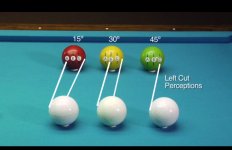Tony, the key to CTE/Pro One and the primary source of disputes has not been pivoting. It has been the visual perceptions and the idea the user uses their pool experience and feel to "adjust" their aim instead of the system being objective. Your idea for the pivoting mechanism is fine but it doesn't serve to resolve the primary issues. I will agree with you however, there has been debates over the pivot. It was discussed with AtLarge and Colin a couple of months ago. Even then, it wasn't fully resolved and the two of them didn't really understand how the bridge hand slides along the perception line to the fixed pivot point and how this offsets varying bridge differences. In general, "I think" we agreed (to an extent - that's a lot of caveats) the varying bridge lengths would have some effect but it was so small that it is irrelevant.
Also I think you missed the point. With my cut-out, it shows how pivoting will naturally give you the right amount to turn to make the shot. If you're trying to land in the center of the cueball, there is a point that is to far, a point that is not far enough, and a point that is just right. If you can act like that cut-out, you would theoretically never miss a shot.
So:
"Cut-Out"
-Line-up visual points to visual points in the exact order each time (ex: Edge to Edge to Back-Foot)
-Your visual will always be the same
-Your pivot will vary based on the shot.
CTE:
-Line-up visual points to visual points in the exact order each time (ex: Edge to A and Center to Edge)
-Your visual will vary based on the shot.
-Your pivot will always be the same.
Do you see how each system is just solving for a different part of the same equation?
As for the varying bridges you're right, it doesn't take into account bridge length. Once you've turned to face the cue ball center, you're on the correct shot line, but it's you're job to put your cue along that that line to make up for the differences in bridge length.


